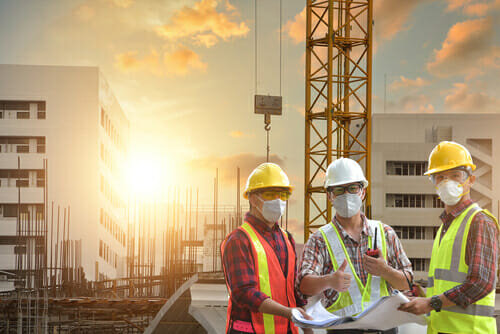
For construction workers, there are many dangerous risks to face. In fact, the cost of injuries within the industry across the UK has reached more than a staggering £16.2 billion a year, truly emphasising the impact that working on a building site can have.
However, despite the overwhelming findings, there are more ways to offer protection thanks to advanced technology.
But how exactly does this work? Here, with some help from van leasing company, Van Ninja, we delve into five ways technology is helping to improve the health and safety of the construction sector.
- Wearable technology
While PPE is an essential measure for construction workers to ensure their health and safety, that’s not to say there’s room for improvement; in fact, there are more items that workers can wear to protect themselves.
Wearable technologies are yet another way that safety can be improved in the construction industry, with many helping monitor vital signs, identify collisions, and keep track of workers who are working unaccompanied. So, if workers are using van leasing to go from site to site, you can keep an eye on them for their safety.
When out and about, especially during rush hours, mishaps can take place at every turn. Even slamming the breaks to avoid colliding with another vehicle or a pedestrian can be harmful. You are likely to suffer an abrupt movement of the head and neck, which may result in whiplash injury.
Susanne McGraw, Head of Personal Injury at Watermans, said: “As part of a team of personal injury lawyers, I support many people who have suffered a whiplash injury when at the wheel of their vehicle. Most of them will recover within days, whereas others have to deal with its effects for weeks or even months. My recommendation is to seek medical assistance as soon as possible. This will give you the chance to get the treatment you need and alleviate feelings of discomfort in a timely manner.”
Exoskeleton is one example of wearable technology which assists the workers’ physical support when there is a high risk of injury.
- Site sensors
There are many risks that can affect the health of a construction worker, but with site sensors, there’s extra protection in place against these.
With site sensors, which companies like SmartSite and Pillar Technologies have developed, many things such as noise levels, temperature, and dust particulates can be monitored to protect the workers from high exposure. Across the construction site, these sensors can be implemented to inform the employees if they are in danger of passing the exposure limit.
- Digitalised safety processes
Turning the safety process to digital instead of having a pile of paperwork will not only provide more time to be used elsewhere, but also contribute to the safety process of the construction site.
With an ePTW system, safety is ensured while making life easier. Digital sign-offs allow for more traceability, and you can rest assured that you have clarity of what’s going on throughout the construction site, thanks to real-time visibility, even if you aren’t on-site. In addition to this, consistent standards can be implemented across various sites, even for different types of construction work. With consistency across teams and visibility over the sites, you can rely on this technology for a safer working environment.
- Drones to monitor sites
It’s essential for site workers to be aware of hazards to avoid major injuries. Thankfully, technology can monitor sites to improve workers’ safety.
Drones are excellent for construction companies as they can be used for an aerial inspection of their site, which offers a wide view of the area and the surrounding environment. Given their ability to reach elevated areas and places that may be deemed unsafe, the inspection is much more accurate and efficient. With this technology, any safety hazards can be spotted prior to work being carried out to identify any procedures that need to be in place.
- Digital training sessions
Training is important in any job role for upskilling, but for the construction industry in particular, it is vital due to the many physical health risks like back injuries and the harmful chemicals in paints.
By streamlining training sessions, all workers across several sites can learn the same information, avoiding miscommunication that could be spread through in-person training through multiple sites. As well as this, sessions can be recorded for workers to revisit to refresh their memory, ensuring excellent safety conditions as employees can become much more familiar with necessary procedures.
Technology provides an abundance of opportunities for many different industries, but given the risks for construction workers, the advancements are particularly useful for this sector due to the ability to improve safety.
